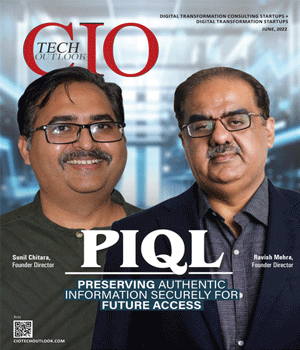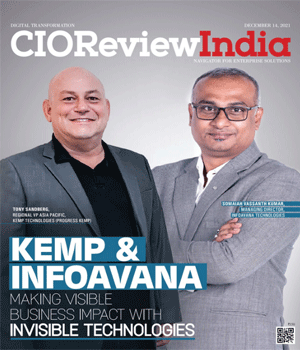
How Machine Vision and Digital Strategy Boosts Manufacturing?
Bhupendra Bhate, CDO, L&T Technology Services | Wednesday, 06 December 2017, 07:35 IST
 Change is inevitable, rather a new constant. Organizations that are averse to change are destined to fail and we all have heard about Kodak and Nokia and very well know the consequences of not adapting to change. Today, organizations are undergoing massive digital transformations not only because their competitors or companies are adapting, it’s because of the benefits that digital transformation is bringing to companies is enormous. This digital era is causing disruption to businesses across many industry sectors. Business leaders are under huge pressure to react appropriately and put digital transformation at the forefront of organizational priorities. To maintain pace and grow a business in today’s climate will require business agility, product and service innovation as well as a shift towards a customer centric model.
Change is inevitable, rather a new constant. Organizations that are averse to change are destined to fail and we all have heard about Kodak and Nokia and very well know the consequences of not adapting to change. Today, organizations are undergoing massive digital transformations not only because their competitors or companies are adapting, it’s because of the benefits that digital transformation is bringing to companies is enormous. This digital era is causing disruption to businesses across many industry sectors. Business leaders are under huge pressure to react appropriately and put digital transformation at the forefront of organizational priorities. To maintain pace and grow a business in today’s climate will require business agility, product and service innovation as well as a shift towards a customer centric model.
The explosion in connected devices and platforms, the abundance of data from field devices and the rapidly changing technological landscape have made it imperative for companies to quickly adapt their products and services and move from the physical world to a digital world. Human experience is vital to raising an organization’s Digital IQ. Businesses must think critically about how their digital initiatives will affect the experience of customers and employees, as even the most well-intentioned initiatives can have unforeseen impacts on people.
For this discussion, we will speak about the always evolving ‘Manufacturing Sector’. The manufacturing industry has been a forerunner in adopting new processes and technologies – right from Kaizen, JIT, and lean principles to robotic automation which has now become the essence of each and every manufacturing organization.
One of the key elements in long-term sustainability of manufacturing companies is continuous improvement, which has given rise to the new era of manufacturing, i.e., Industrie 4.0. So, when we talk about digital transformation, what do we really mean? What do companies trying to achieve? Industry 4.0 has changed manufacturing. At a high-level, Industry 4.0 represents the vision of the interconnected factory where all equipment is online and, in some way, is also intelligent and capable of making its own decisions. Manufacturing and packaging industries are the major sectors where the automation is happening. Within manufacturing operation, speed, efficiency, and quality are among top concerns for producers. When it comes to detecting and eliminating damaged goods, these concerns are as important as ever.
There are many key technologies which are playing important role in digitally transform the manufacturing sector. Now Machine Vision, Artificial Intelligence and Virtual Reality are also emerging as key technologies. Machine Vision technology solutions for manufacturing and packaging do not only improve your efficiency and productivity, but also the quality and safety of your products and manufacturing line. Additionally, vision systems technology provides actionable data to drive real-time production statistics and process control. Vision systems are also capable of serializing specific components, which makes the tasks of tracking and tracing more-readily achievable. As the sensors have become more advance and smart the benefits of vision system have increased even more and the system has become more efficient and reliable. From the recent past, Artificial Intelligence is emerging in Machine Vision. With advanced Artificial Intelligence in Machine Vision, industries will be able to solve the complex problems with ease by virtue of increased computational capabilities.
Downtime and reliability are critical when it comes to the operation of equipment and machines on a shop floor. With big data analytics, the quick and easy access to operation data, production information, and inventory means quality data that gives the ability to quickly adjust to machine status across the enterprise.
Quality and yield are directly related to manufacturing processes as to how raw materials are used, inspected, manufactured, and how everything comes together. This really determines the quality level of the products. Cognitive computing enables early identification of emerging quality problems, increased production yield, and reduction of problems that lead to service and warranty costs.
It should be noted that all businesses are not prepared for transformation. Multiple factors can prevent these programs from working. There are multiple drivers for digitalization or digital transformation. Some of them are having aligned work force that takes data based decision, transparency about back traces in different parts of value chain, rapid decision-making, business scenario changes and Internal & External collaboration.
Now that we have touched upon the digital transformation, its need, impact on manufacturing sector and key technologies involved. Let’s take a look at the most important factor when it comes to digitalizing your business, Digital ROI. Companies can’t invest heavily in Digitalization only because its competitors are doing. They should check the affordability and Digital ROI. Digital ROI realization allows companies to measure how well investments are giving returns during a digital transformation. It helps them to decide whether they should hold or push harder for more investment.
I would like to mention that history has proved that any disruption is available only for a limited window, before a new disruption comes. Same is true for digital transformation. If not done today our business will be left and struggling to match the pace with others. So, make the move and keep transforming.
CIO Viewpoint
The Constantly Evolving Technology Landscape in...
By Janifha Evangeline
Navigating the Digitalization of Mining Industry
By Janifha Evangeline
How To Achieve An Effective Digital Transformation
By Yogendra Singh, Head-IT/SAP, Barista Coffee Company Limited
CXO Insights
No-code platforms: Enterprise-wide Adoption...
By Rahul Murthi, Director at Acies
Unleashing the Potential of IT in Engineering...
By Gyan Pandey, Head - Digital/CDO, Voltas
Low Code and Artificial Intelligence - The...



.jpg)

.jpg)





